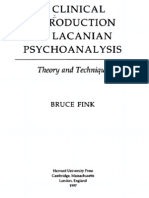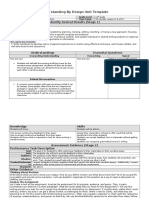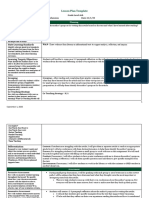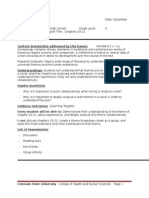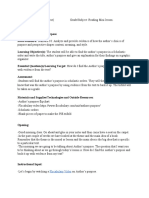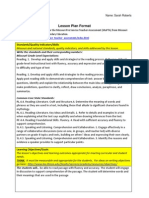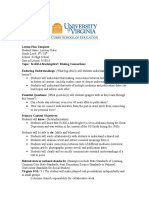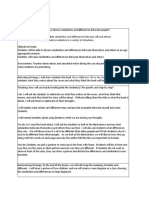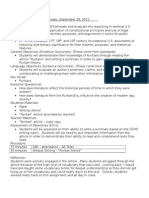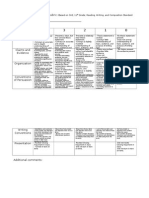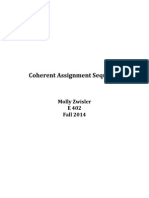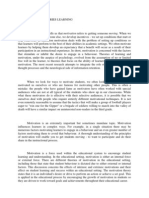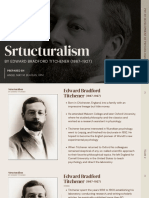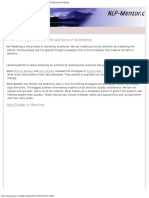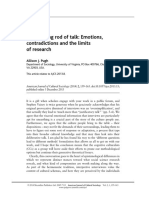Tws Lesson Plan
Tws Lesson Plan
Uploaded by
api-257584473Copyright:
Available Formats
Tws Lesson Plan
Tws Lesson Plan
Uploaded by
api-257584473Original Title
Copyright
Available Formats
Share this document
Did you find this document useful?
Is this content inappropriate?
Copyright:
Available Formats
Tws Lesson Plan
Tws Lesson Plan
Uploaded by
api-257584473Copyright:
Available Formats
STEPP Lesson Plan Form
Teacher: Molly Zwisler
Grade Level: 7th Grade
Date: Summer 2014
Content Area:
English
Title: The Truth Behind Authors Purpose in To Kill a Mockingbird
Content Standard(s) addressed by this lesson:
(Write Content Standards
directly from the standard)
Content Area: Reading, Writing, and
Communicating
Standard 2.3: Evaluate how an author uses words to create mental imagery,
suggest mood, and
set tone; purpose, tone and meaning in word choices influence literary,
persuasive, and
informational text.
Understandings: (Big Ideas)
I want students to understand that literature transcends purpose through the
decisions the author makes in their writing.
Inquiry Questions: (Essential questions relating knowledge at end of the unit of
instruction, select applicable questions from standard)
1. How do outside influences affect the author and their purpose?
2. Why do writers write?
3. What can literary texts relay to us about the world, past, present, and future?
Evidence Outcomes: (Learning Targets)
Every student will be able to: (Create your own lesson objectives from the
standard, follow the ABCD format, using student voice)
I can: explain and describe how literature transcends purpose.
This means:
Students will be able to explain how authors decisions in their writing create a
larger purpose in their text.
Students will be able to describe how outside factors influence the purpose of their
writing.
Students will be able to self-reflect on their own decisions in their writing and the
influences that shape their writing.
Colorado State University College of Health and Human Sciences
Page 1
STEPP Lesson Plan Form
List of Assessments: (Write the number of the learning target associated with
each assessment)
Do Now: Students will be asked what they think an authors purpose is and how it
affects an authors writing. (Pre-assessment, LT #1)
Discussion about Harper Lees purpose in To Kill a Mockingbird: Students will be
asked to try to pinpoint the authors purpose in the text and pull evidence as to why.
(During assessment, LT #2)
Quick-Write/ Ticket out the door: Students will be asked as a conclusion activity to
reflect on why they chose to write the way they do and what factors outside of
themselves effect that. (Post assessment, LT #3)
Colorado State University College of Health and Human Sciences
Page 2
STEPP Lesson Plan Form
Planned Lesson Activities
Name and Purpose of Lesson
Should be a creative title for you and the
students to associate with the activity.
Think of the purpose as the mini-rationale
for what you are trying to accomplish
through this lesson.
Approx. Time and Materials
How long do you expect the activity to
last and what materials will you need?
Title: Harper Lee Has a Greater Purpose Than the Death of a
Mockingbird?
Purpose: I want students to understand that Harper Lee made
decisions while writing the text that create a larger purpose and larger
social context than simply a book about a trial about a black man.
Students will analyze the authors purpose in order to come to the
conclusions about the larger purpose Lee was trying to create, through
his writing. Students need to be able to read a text and understand the
larger social context for a piece of writing and they will begin to
practice this throughout this lesson.
This lesson will take approximately one 90 minute class period.
Students Materials:
Copy of To Kill a Mockingbird
Reading Thinking Journal (used to hold student thinking)
Basic materials
Teacher Materials:
Copy of To Kill a Mockingbird
Doc Cam
Anticipatory Set
The hook to grab students attention.
These are actions and statements by the
teacher to relate the experiences of the
students to the objectives of the lesson,
To put students into a receptive frame of
mind.
To focus student attention on the
lesson.
To create an organizing framework
for the ideas, principles, or
Do Now: Today we are going to begin a unit on Purpose, specifically
authors purpose in the text they write. In youre Reading Thinking
Journal come up with a definition of literary purpose and how it would
be different than authors purpose.
When finished with this, you will get with your shoulder partner and talk
about this in relation to To Kill a Mockingbird. Discuss what you think
Harper Lees purpose is in writing the text. (as students are discussing,
I will be walking around the classroom, pushing students thinking and
taking notes on some of the things they bring up to discuss when we
have the whole class discussion) (9:00-9:10)
Colorado State University College of Health and Human Sciences
Page 3
STEPP Lesson Plan Form
information that is to follow
(advanced organizers)
An anticipatory set is used any time a
different activity or new concept is to be
introduced.
How do you intend to engage your
students in thinking during the
Anticipatory Set?
Why are you using it at this point in
your lesson?
Procedures
(Include a play-by-play account of what
students and teacher will do from the
minute they arrive to the minute they
leave your classroom. Indicate the length
of each segment of the lesson. List actual
minutes.)
Indicate whether each is:
-teacher input
-modeling
-questioning strategies
-guided/unguided:
-whole-class practice
-group practice
-individual practice
-check for understanding
-other
From here, I would then go into the procedure with students, starting
with a small discussion about what authors purpose actually is.
My students Reading Thinking Journal will be how they are holding their
thinking in this anticipatory set. While students will first hold their
thinking in their journal, they will then be able to share their thinking
out loud to discuss more in depth their thinking. I am using this
because students will be able to look back at their initial thoughts and
perceptions about authors purpose at the end of the lesson and see
how their thinking will grow; I will also be able to.
After students have spent their time thinking out loud with their
shoulder partner, I will then ask students to share some of the
ideas they have come up with. (9:10-9:15)
I will then offer students a definition of authors purpose in which
students will be expected to write down in their notes: (9:159:25)
o Authors purpose: the reason an author decides to write
about a specific topic. Then, once a topic is selected, the
author must decide whether his purpose for writing is to
inform, persuade, entertain, or explain his ideas to the
reader. (gourmetlearning.com)
o Here I will explain to students how authors may choose
what to write about based on a multitude of factors in their
life that they have no control over:
Familial problems
Class
Race
Society (war, stock market, civil rights)
As a class, we will discuss how an author chooses their purpose
and the different genres that relate to each. (9:25-9:45)
o Here I will model going through two different genres that
have different authors purposes and how I can determine
Colorado State University College of Health and Human Sciences
Page 4
STEPP Lesson Plan Form
How do you intend to engage your
the authors purpose from the language used.
Then, in groups of 2-3, students will be given a stack of different
genres and they must as a group discuss and decide about the
authors purpose in writing what they did. (9:45-10:05)
o Each group will be given: a newspaper article, a blog post,
a magazine article, a scholarly journal article, a class
description from the course catalog, and a short story.
o In their Reading Thinking Journal students will be expected
to record their thinking about each genre of text and what
the authors purpose could be and why.
o As students are in their groups, I will be walking around to
each group and have them walk me through their thinking
and decision making process.
After students are finished with this activity, I will have them
begin to think about Harper Lees purpose in To Kill a
Mockingbird. (10:05-10:10)
o I recognize that the book is a more difficult text to identify
for students because it is a much longer text, perhaps with
multiple purposes within one text.
Before asking students to share their thinking in
regard to authors purpose in TKAM, students will
investigate throughout their text with a partner,
finding evidence to support their claims in regards
to Lees purpose in the text.
As students are finishing their discussions, I will have students
write what each group thought about Lees purpose. We will then
go through each group asking them to explain their claim and
their thinking behind their claim. (10:10-10:20)
o Here, I hope that students will understand the point that
authors purpose can be multiple different things and will
transcend what the text actually has to say. The purpose
comes from context and the context of TKAM has changed
over time but still remains present and relevant in todays
society.
By allowing students hands on activities and letting them explore the
Colorado State University College of Health and Human Sciences
Page 5
STEPP Lesson Plan Form
students in thinking during the
PROCEDURE?
Why are you using it at this point in
your lesson?
Closure
Those actions or statements by a teacher
that are designed to bring a lesson
presentation to an appropriate conclusion.
Used to help students bring things
together in their own minds, to make
sense out of what has just been taught.
Any Questions? No. OK, lets move on is
not closure. Closure is used:
To cue students to the fact that
they have arrived at an important
point in the lesson or the end of a
lesson.
To help organize student learning
To help form a coherent picture and to
consolidate.
How do you intend to engage your
students in thinking during
CLOSURE?
Why are you using it at this point in
your lesson?
Differentiation
To modify: If the activity is too advanced
for a child, how will you modify it so that
they can be successful?
topic in real world and applicable texts that students see on daily basis
and then connecting that to a book that seems a farther away from
them, allows students to really experience the topic and be involved in
it so it is applicable to them. Students are also being held accountable
by their group members to hold their thinking in their Reading Thinking
Journal and also being active participant within their groups. This is
helping me as a teacher, help students, as I am able to figure out what
individual students need because the instruction is more one-on-one
with students.
This closure activity will take place from 10:20 to 10:30. Once we have
finished our discussion about TKAM and Lees purpose, students will be
asked to do a quick write answering the following questions:
Why does To Kill a Mockingbird still remain a relevant text in our
society?
What does Lees purpose tell us about our past, present, and
future?
Why is this relevant to your life? (This will be something that we
will talk about the next day in class in order to discuss the idea
that literature transcends purpose).
Students will turn this in as they walk out of the room. And I will use
this to assess whether students have gained the understanding that I
set forth and are able to answer the essential questions in regards to To
Kill a Mockingbird.
I am using this ticket out the door to make sure that all students are
proficient in understanding authors purpose is often much larger than
the purpose of the literature at hand. This is a way for me to check
students understandings of the new material and their ability to apply
it to their life and the relevancy that it has in their life.
To differentiate the activities at hand I would put students into groups
based on their skill level and their understanding of what purpose is.
From here I would be very purposeful in the examples of different
genres I gave to each group, to challenge them while still allowing them
Colorado State University College of Health and Human Sciences
Page 6
STEPP Lesson Plan Form
To extend: If the activity is too easy for a
child, how will you extend it to develop
their emerging skills?
Assessment
How will you know if students met the
learning targets? Write a description of
what you were looking for in each
assessment.
to be successful. I would give some groups articles that were much
more clear in the authors purpose, while giving more advanced groups
more difficult articles where the authors purpose may not be so
obvious.
LT #1: Students will have met this learning target if they are able to
describe and identify what authors purpose is and, or, revise their
original definition of authors purpose and how to identify it within To
Kill a Mockingbird. While this starts in the Do Now, this learning
targets proficiency will become obvious as the lesson continues and
students are either succeeding or struggling identifying the authors
purpose in the different genres.
LT #2: Students will have met this learning target if they are able to
identify and claim Lees purpose in the text using support evidence
from the actual text. When students are explaining their claims they
will need to associate it to the social issues that occur throughout the
text and how that relates to Lees purpose.
LT #3: In the conclusion students will do a quick write where their final
question is to reflect on the relevancy of this idea and concept in their
life. If students are able to reflect on a texts ability to transcend its
time and place for a large and substantial purpose in the context of
society.
Colorado State University College of Health and Human Sciences
Page 7
STEPP Lesson Plan Form
Post Lesson Reflection
1. To what extent were lesson objectives achieved? (Utilize
assessment data to justify your level of achievement)
2. What changes, omissions, or additions to the lesson would
you make if you were to teach again?
3. What do you envision for the next lesson? (Continued practice,
reteach content, etc.)
Colorado State University College of Health and Human Sciences
Page 8
You might also like
- A Clinical Introduction To Lacan - FinkDocument309 pagesA Clinical Introduction To Lacan - FinkIvan Dulov100% (9)
- Eric Drew Whitman - Cashvertising - SummaryDocument10 pagesEric Drew Whitman - Cashvertising - SummaryUUU001No ratings yet
- The Bet Lesson PlanDocument10 pagesThe Bet Lesson Planapi-265180782100% (1)
- Ubd Lesson Plan Template: Vital InformationDocument4 pagesUbd Lesson Plan Template: Vital Informationapi-283334474No ratings yet
- Authors Purpose Lesson PlanDocument5 pagesAuthors Purpose Lesson Planapi-264589119No ratings yet
- Comprehension Lesson PlanDocument2 pagesComprehension Lesson Planapi-577230763No ratings yet
- Term III Literature Lesson Plan Prof CommentsDocument6 pagesTerm III Literature Lesson Plan Prof Commentsapi-269809853No ratings yet
- Strategy Lesson 1Document5 pagesStrategy Lesson 1api-484708169No ratings yet
- Evidence 5: Assessing, Teaching, Differentiating, Unit-Based Instruction By: Emily EdwardsDocument27 pagesEvidence 5: Assessing, Teaching, Differentiating, Unit-Based Instruction By: Emily Edwardsapi-279611166No ratings yet
- How To Motivate Your Students With A Book: The ProblemDocument4 pagesHow To Motivate Your Students With A Book: The Problembugoff700No ratings yet
- Writing Circles UnitDocument15 pagesWriting Circles Unitapi-254712134No ratings yet
- Richard Cory Co-Plan Lesson PlanDocument4 pagesRichard Cory Co-Plan Lesson Planapi-534097479No ratings yet
- Understanding by Design Unit TemplateDocument5 pagesUnderstanding by Design Unit Templateapi-318155534No ratings yet
- Lesson Plan #1 1. Descriptive DataDocument16 pagesLesson Plan #1 1. Descriptive Dataapi-220232621No ratings yet
- Intro Lesson Plan To Genre Analysis UnitDocument5 pagesIntro Lesson Plan To Genre Analysis UnitDanahNo ratings yet
- Ubddd Unit TemplateDocument4 pagesUbddd Unit Templateapi-318256564No ratings yet
- Lesson Plan Template: Essential QuestionDocument4 pagesLesson Plan Template: Essential Questionapi-531359166No ratings yet
- Lesson Plan Template: Brigham Young University-Hawaii School of EducationDocument5 pagesLesson Plan Template: Brigham Young University-Hawaii School of Educationapi-402185656No ratings yet
- Lesson Plan 3Document3 pagesLesson Plan 3api-664564177No ratings yet
- 4th Observation Lesson About WritingDocument4 pages4th Observation Lesson About Writingapi-597953642No ratings yet
- Grimesey lp4 FinalDocument4 pagesGrimesey lp4 Finalapi-341187427No ratings yet
- March 10-14 Week 2Document25 pagesMarch 10-14 Week 2api-252534442No ratings yet
- 1984 Unit PlanDocument11 pages1984 Unit Planapi-313091915No ratings yet
- Lesson Plan Recognizing AudienceDocument21 pagesLesson Plan Recognizing AudienceCPaulE33No ratings yet
- DB 5Document6 pagesDB 5api-283308129No ratings yet
- The Outsiders Novel UnitDocument33 pagesThe Outsiders Novel Unitsgavan50% (4)
- Writing UnitDocument15 pagesWriting UnitAnonymous DPwpbRI7ZKNo ratings yet
- Ela Lesson Plan - Persuasive Language - 4th GradeDocument5 pagesEla Lesson Plan - Persuasive Language - 4th Gradeapi-316613434No ratings yet
- Teacher: Christina Mastropolo Lesson Number: Lesson Title: Describing Our Lives Grade/Subject: 2 GradeDocument5 pagesTeacher: Christina Mastropolo Lesson Number: Lesson Title: Describing Our Lives Grade/Subject: 2 Gradeapi-301885873No ratings yet
- Writing Mini Lesson Samantha SchwabDocument13 pagesWriting Mini Lesson Samantha Schwabapi-357033410No ratings yet
- Expository Lesson PlanDocument6 pagesExpository Lesson Planapi-265180782100% (2)
- Tkam Lesson4Document5 pagesTkam Lesson4api-257595875No ratings yet
- Subject and Grade Level: Suggested Length of Unit: 2 Weeks Common Core State Standards AddressedDocument6 pagesSubject and Grade Level: Suggested Length of Unit: 2 Weeks Common Core State Standards Addressedapi-269465073No ratings yet
- Lesson Plan Template EDIS 5400: English EducationDocument9 pagesLesson Plan Template EDIS 5400: English Educationapi-340887844No ratings yet
- "4 Styles of Writing": Grade 9 English Language Arts Miss. Denyer Duration: October 31 - November 25Document9 pages"4 Styles of Writing": Grade 9 English Language Arts Miss. Denyer Duration: October 31 - November 25api-299681637No ratings yet
- Cep Lesson PlanDocument6 pagesCep Lesson Planapi-318256564No ratings yet
- Headly El Dador 5Document5 pagesHeadly El Dador 5api-210163638No ratings yet
- Tkam Lesson 11Document5 pagesTkam Lesson 11api-257595875No ratings yet
- Note: Refer To The List in The Document Called "Concept Unit Lesson Plans"Document20 pagesNote: Refer To The List in The Document Called "Concept Unit Lesson Plans"api-317648195No ratings yet
- 5-1-5FINAL CCSSO High School English - Short Stories PDFDocument9 pages5-1-5FINAL CCSSO High School English - Short Stories PDFDominic OntogNo ratings yet
- Authors PurposeDocument5 pagesAuthors Purposeapi-455372315No ratings yet
- Lesson On Chloe and The Lion 1Document3 pagesLesson On Chloe and The Lion 1api-203262811No ratings yet
- Small Group Lesson PlanDocument24 pagesSmall Group Lesson Planapi-205969604No ratings yet
- 1st Day of Class ActivitiesDocument5 pages1st Day of Class ActivitiesJs ParkNo ratings yet
- Foggy FigureDocument6 pagesFoggy Figureapi-281523380No ratings yet
- Final Project Tianyu & YuanyuanDocument25 pagesFinal Project Tianyu & Yuanyuanapi-273812723No ratings yet
- Lesson Plan TemplateDocument5 pagesLesson Plan Templateapi-298026665No ratings yet
- Instructional PlanDocument19 pagesInstructional Planapi-354007473100% (1)
- 5 Unit Lesson Plan 5Document5 pages5 Unit Lesson Plan 5api-337360126No ratings yet
- Identifying Theme Unit OverviewDocument7 pagesIdentifying Theme Unit Overviewapi-3408051650% (1)
- Missouri Pre-Service Teacher Assessment (Mopta) : Lesson Plan FormatDocument9 pagesMissouri Pre-Service Teacher Assessment (Mopta) : Lesson Plan Formatapi-356518929No ratings yet
- Kaler lp2Document6 pagesKaler lp2api-317643240No ratings yet
- Poetry UnitDocument18 pagesPoetry Unitapi-211634867No ratings yet
- Dark Ages Lesson PlanDocument9 pagesDark Ages Lesson Planapi-310437278No ratings yet
- 5e Gathering Resources Lesson PlanDocument3 pages5e Gathering Resources Lesson Planapi-608907857No ratings yet
- Writers WorkshopDocument3 pagesWriters Workshopapi-253194982No ratings yet
- UNLV/Department of Teaching & Learning Elementary Lesson Plan TemplateDocument4 pagesUNLV/Department of Teaching & Learning Elementary Lesson Plan Templateapi-342077749No ratings yet
- Strategy Lesson 1Document15 pagesStrategy Lesson 1api-531900355No ratings yet
- Mini LessonsDocument3 pagesMini Lessonsapi-677939251No ratings yet
- Summary (Learning and Teaching Strategies)Document15 pagesSummary (Learning and Teaching Strategies)MaizarahNo ratings yet
- Read 436-Qri Lesson PlansDocument12 pagesRead 436-Qri Lesson Plansapi-251375394No ratings yet
- Teaching Literature & Writing in the Secondary School ClassroomFrom EverandTeaching Literature & Writing in the Secondary School ClassroomNo ratings yet
- Instruction and Management PlanDocument23 pagesInstruction and Management Planapi-257584473No ratings yet
- Ylp CalendarDocument10 pagesYlp Calendarapi-257584473No ratings yet
- Persuasive Writing Project Rubric Student Name: (Based On CAS 11 Grade Reading, Writing, and Composition Standard 3.2)Document3 pagesPersuasive Writing Project Rubric Student Name: (Based On CAS 11 Grade Reading, Writing, and Composition Standard 3.2)api-257584473No ratings yet
- Zwisler Molly CasDocument35 pagesZwisler Molly Casapi-257584473No ratings yet
- Tat Title PageDocument34 pagesTat Title Pageapi-257584473No ratings yet
- Final Project Unit PlanDocument3 pagesFinal Project Unit Planapi-257584473No ratings yet
- BullseyesDocument1 pageBullseyesapi-257584473No ratings yet
- 102 - OB SyllabusDocument1 page102 - OB SyllabusganeshNo ratings yet
- Art Lesson Plan 3Document2 pagesArt Lesson Plan 3api-263764827No ratings yet
- Argumentative Sample Essay: Does Age Matter in RelationshipsDocument2 pagesArgumentative Sample Essay: Does Age Matter in RelationshipsJessica UyNo ratings yet
- BRM Unit1Document51 pagesBRM Unit1SivaKumar RNo ratings yet
- Evaluating MYP Unit PlansDocument23 pagesEvaluating MYP Unit PlansLorraine SabbaghNo ratings yet
- Motivational Theories LearningDocument5 pagesMotivational Theories LearningNur Atiqah AbdullahNo ratings yet
- Episode 5 fs6Document12 pagesEpisode 5 fs6Mark Anthony Nieva Rafallo75% (8)
- Evaluation in Urban Planning Advances An PDFDocument20 pagesEvaluation in Urban Planning Advances An PDFFahmy AtNo ratings yet
- Unit 2-Individual BehaviourDocument11 pagesUnit 2-Individual BehaviourRobin VarshneyNo ratings yet
- Johnson Donohue Business Communication 1994Document14 pagesJohnson Donohue Business Communication 1994Athirah Rerana FitrianthyNo ratings yet
- Theoretical Perspectives in Motor SkillsDocument16 pagesTheoretical Perspectives in Motor SkillsJames Rohan CruzNo ratings yet
- How To Win The Lottery Using The Law of Attraction THEixtkaDocument5 pagesHow To Win The Lottery Using The Law of Attraction THEixtkaovencheque09No ratings yet
- StructuralismDocument34 pagesStructuralismangelmayb06No ratings yet
- Major Sociological Theories: Symbolic Interaction TheoryDocument2 pagesMajor Sociological Theories: Symbolic Interaction Theoryjj jamandreNo ratings yet
- Class Orientation - TrendsDocument19 pagesClass Orientation - TrendsMarianne ChristieNo ratings yet
- Understanding Communication in Multicultural SettingsDocument22 pagesUnderstanding Communication in Multicultural SettingsAnonymous Pao1QBmJNo ratings yet
- What Is A Literature Review?Document7 pagesWhat Is A Literature Review?Dennoh VegazNo ratings yet
- Disciplines and Ideas in The Applied Social Sciences Quarter 3: Weeks 3&4 MELC: Describe The Clientele of CounselingDocument12 pagesDisciplines and Ideas in The Applied Social Sciences Quarter 3: Weeks 3&4 MELC: Describe The Clientele of CounselingSharon May JavierNo ratings yet
- BlueprintToCultureTransformation Oct6FINALDocument44 pagesBlueprintToCultureTransformation Oct6FINALmstpfisherNo ratings yet
- Research Designs: Dr. Khalid Manzoor ButtDocument22 pagesResearch Designs: Dr. Khalid Manzoor ButtNabiha FatimaNo ratings yet
- Exploring Speech Therapy Games With Children On The Autism SpectrumDocument5 pagesExploring Speech Therapy Games With Children On The Autism SpectrumEleni KeniniNo ratings yet
- NLP Modeling, Finding The Structure of ExcellenceDocument6 pagesNLP Modeling, Finding The Structure of ExcellenceSan HeNo ratings yet
- The Teaching Profession: Formal Education Refers To The Hierarchically StructuredDocument31 pagesThe Teaching Profession: Formal Education Refers To The Hierarchically StructuredJaneNo ratings yet
- Allison Pugh - The - Divining - Rod - of - TalkDocument6 pagesAllison Pugh - The - Divining - Rod - of - TalkRenan William dos SantosNo ratings yet
- School Performance, Leadership and Core Behavioral Competencies of School Heads: Does Higher Degree Matter?Document7 pagesSchool Performance, Leadership and Core Behavioral Competencies of School Heads: Does Higher Degree Matter?Manuel CaingcoyNo ratings yet
- Synopsis MSNDocument23 pagesSynopsis MSNSaurabh MNo ratings yet
- The Relationship Between Academic Intelligence and Procrastination of Grade 12 StudentsDocument5 pagesThe Relationship Between Academic Intelligence and Procrastination of Grade 12 Studentsjeliena-malazarteNo ratings yet
- Coaching PPT ShowDocument40 pagesCoaching PPT ShowZaryna TohNo ratings yet
